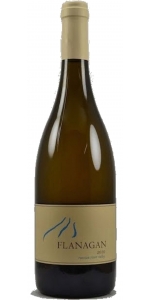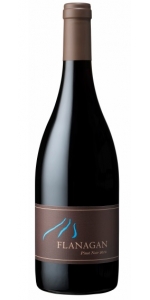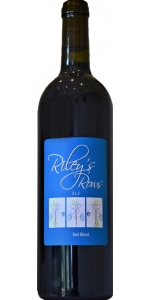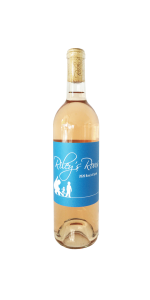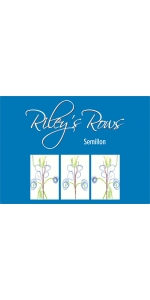Wine from Flanagan Winery
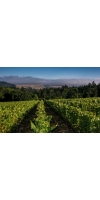
Flanagan Winery:
Eric Flanagan is the founder and visionary behind the Flanagan wines and Flanagan brand.
Our journey into wine began with a love of wine and an appreciation of the places that create unique wines. In the early 1990’s, wine quality exploded higher in Sonoma and Napa. It was an exciting time to be a consumer of wines from Northern California and a great time to come and meet the vintners who were responsible for these inspiring new wines. We began in 1999 with the purchase of forty acres in Bennett Valley. In 2011, we acquired a small Russian River Valley vineyard, and, starting with the 2014 vintage, we have added vineyard designated wines from top vineyards in the Russian River Valley and the Sonoma Coast. Vineyard sources now include Ritchie Vineyard and Bacigalupi Vineyard for Chardonnay, and Sunchase and Sonoma Stage for Pinot Noir. In 2015, we will also add the iconic Platt Vineyard as a source for both Chardonnay and Pinot Noir. We believe that Platt may be the best vineyard in California for those varieties.
Sustainability at Flanagan:
There are a few marketing buzzwords that are prevelant in the wine industry right now that can be very confusing to the consumer. Terms like organic, biodynamic, sustainable... What exactly do those terms mean? To us, it's very simple. Sustainabliltiy means we farm our vineyards with long term mindset. We do everything we can to ensure that this land will be as healthy, or healthier than it was when we found it. We are in the process of having our vineyards certified as sustainable by the California Sustainable Winegrowers Alliance "CSWA".
Sonoma County is making a huge push to be the first farm community to be 100% certified sustainable. The CSWA program has 138 catagories for vineyard owners to self assess and then they support the process with an outside auditor. Sonoma County has hired a full time sustainablility coordinator and is making great progress towards our goal of have all of the vineyards in Sonoma County farmed sustainably.
Proprietor Eric Flanagan:
Eric came to the wine business from a love of wine. His family did not own a winery or a vineyard, and Eric did not grow up on a farm. Through his travels Eric became fascinated by how grapes of the same variety expressed themselves in different places. From New Zealand to Greece, Eric visited wine growing regions around the world, but in the late 90's he chose to create his vision in Sonoma. He started in 1999 with the purchase of 40 acres on the side of Bennett Mountain and expanded in 2011 with the purchase of their Russian River Valley site. Flanagan is now producing wines from several of the top vineyards in Sonoma County under their vineyard designate program. Flanagan is becoming known for making great wines from the best vineyards in Sonoma County.
Eric, Kit, and their 3 daughters (Riley, Lola, and Ruby) make their home at the Three Starrs Vineyard along with 3 dogs, 10 ducks, 4 Dwarf Nigerian goats, 2 geese, 1 donkey, and 1 mule (also named Ruby).
Winemaker Cabell Coursey:
Cabell joined Flanagan Vineyards as Winemaker in 2014. His obsession with winemaking began with a harvest in Burgundy while he was enjoying an undergraduate semester abroad. After finishing his B.S., Cabell spent a few vintages picking grapes and scrubbing floors in Burgundy, and then moved up to Oregon’s Willamette Valley. Following his time in Oregon, Cabell traveled to Christchurch, New Zealand, where earned degrees in Enology and Viticulture from Lincoln University. During his time in New Zealand Cabell focused on cool climate viticulture, which serves him very well in his current role at Flanagan. Cabell has also held winemaking positions at Alder Springs Vineyard, Dumol, and Kosta Browne.
Cabell’s approach to winemaking is to use his senses in conjunction with his knowledge in biology, chemistry, and farming.
Cabell describes his philosophy:
“Winemaking is the culmination of a vast number of decisions. Starting with the site, the farming practice, the response to weather conditions, the picking date, the tank and barrel programs, ferment protocols, and continuing through blending and bottling. It is the daily decisions, actions, and sometimes lack of action that unlocks a vineyard’s highest potential. This quest to reveal each vineyards unique personality, while dealing with the challenges inherent in farming, is what makes winemaking challenging, interesting, and highly rewarding. My goal is always the same, to deliver each vineyard’s best expression in each vintage and to make a wine where the last glass is better than the first.”
The vineyards represents 69 acres in total:
Graves vineyards is 13 acres, planted with Syrah (6 acres), Cabernet Sauvignon (4 acres) and Merlot (3 acres).
Platt vineyards is 34 acres, planted with Chardonnay (13 acres) and Pinot Noir (18 acres) and Riesling (1.4 acres)
and Gaps View is 22 acres, all planted with Pinot Noir.
Flanagan Russian River Chardonnay is made from 100 percent Chardonnay.
Grapes for this wine are sourced from several top Russian River Chardonnay sites including Platt Vineyard, Ritchie Vineyard and Bacigalupi Vineyard.
A typical day in Russian River begins with cool fog that fades by mid-morning as the warm sun transforms the vineyard into a warm, welcoming place buzzing with bees. In the late afternoon the ocean air sweeps in from the west cooling the vineyard down. Soils of clay and volcanic rock, carved into rolling hills by the Russian River, are the bass line to the melody played by the sun, wind and fog.
Flanagan Chardonnay RRV has an expressive nose that is typical of the Wente Clone of Chardonnay. The palate has an elegant mélange of stone fruit and ripe citrus flavors supported by understated barrel notes. The key to the wine is the bright acidity that ties everything together. This is a great example of what top Russian River Chardonnay sites can produce when wine making is focused on balance.
The Sonoma Coast AVA is becoming known as the top source for cool climate Pinot Noir. Flanagan Pinot Noir is founded in letting each site and each vintage express itself. They do not have a dogmatic approach to wine-making. Pinot Noir, more than any other grape variety, is made in the vineyard.
The nose is reminiscent of Chambord with rich raspberry notes. The palate has great depth of fruit and notes of Christmas spices like clove and nutmeg. The wine displays vibrant acidity and has a very clean finish. Our Flanagan Pinot Noir Sonoma Coast pairs beautifully with duck, salmon, pork and game; like pheasant, venison, and elk.
Riley's Rows 3x3 Red Blend is made from 36% Cabernet Sauvignon, 35% Syrah, 29% Merlot
Riley’s Rows "Three by Three" Proprietary Red Blend North Coast is a great wine from some of the winery's favorite North Coast vineyard sites. The Merlot is from their Brandt ranch in Lake County…which, is one of the best vineyards in Lake County. The Cabernet and Syrah are both from great Sonoma County sites.
Riley’s Rows 3 x 3 displays a nose of ripe plum and Bing cherries with a hint of cocoa. The palate opens with ripe red berries. The mid-palate offers a delicious melange of blackberry, Rainer Cherry, and nutmeg. The wine has a long finish, very balanced acidity, and soft tannins. The wine is approachable now but will age nicely for many years to come!
Rileys Rows Rose of Syrah is made from 100 percent Syrah.
When I think about my rosé one word comes to mind: intentional. Made from 100% syrah and pressed off skins in the Provencal style this wine is not just an afterthought. Typically picked in mid-October from a cool climate site the fruit comes in with both chemical and flavor ripeness. The result is a low alcohol, fresh wine with a complete flavor profile
Very clean and fresh. Notes of honeysuckle and peach blossom in the nose. White nectarine and charentais melon on the palate. Fresh, clean, and nice salinity on the finish.
Pairs with melon and proscutto, mild cheeses, fresh shellfish.
- back
Selected Options
Wineries
Categories
Pricing
Countries
Regions
Grape Types
Wineries
Organic/Free Shipping
Wolfberger Cremant d Alsace Rose Brut is 100 % Pinot Noir.
The wines from Alsace date back to 589 A.D., but Cremant d’Alsace has more recent beginnings, starting in 1900. Dopff au Moulin (founded in 1574) was the first to produce Cremant d’Alsace in the Method Champenoise style. Cremant d’Alsace received AOC status for sparkling wine in 1976. Two types of Cremant are produced today, resulting in about 2.5 million+ cases of Cremant d’Alsace production annually:
- Cremant d’Alsace, Brut – represents the majority of Cremant d' Alsace production. Uses Pinot Blanc, Pinot Gris, Pinot Noir, Riesling, Auxerrois, and Chardonnay.
- Cremant d’Alsace, Brut Rosé – much rarer, as it is 100% Pinot Noir only.
Wolfberger's Cremant d'Alsace Rose Brut displays a lovely delicate salmon color with active, small bubbles. Round and full-bodied, this Cremant Rose displays beautiful watermelon and strawberry aromas cascading in a smooth finish. A minimum of 15 months bottle aging before disgorging ensures ripeness.
Domaine de Beaurenard Chateauneuf-du-Pape Blanc is made from Clairette blanche & Rose, Grenache Blanc & Gris, Bourboulenc, Roussanne, Picpoul and Picardan.
Gold bright green color. Expressive nose with pear and stone fruits aromas (peach, apricot) with jasmine and roasted almonds notes. The mouth is smooth and fleshy like stone fruit we can smell, with a long a nice finish.
Review:
Always terrific, the 2023 Châteauneuf Du Pape Blanc is no exception, and readers who love vibrant, age-worthy Rhône whites can safely buy this cuvée in just about every vintage. Based on 30% Clairette, 20% Grenache Blanc, 25% Bourboulenc, 22% Roussanne, and splashes of Picardan and Picpoul Blanc, the 2023 reveals a medium gold hue as well as textbook aromatics of pear and orchard fruits intermixed with honeyed flowers, chalky minerality, and subtle green almond nuances. This balanced, medium-bodied, vibrant white is very much in the fresh, focused, yet still textured, approachable style of the vintage.
-Jeb Dunnuck 93 Points

